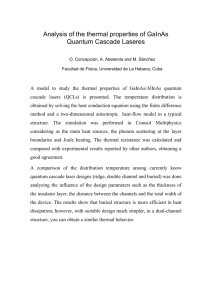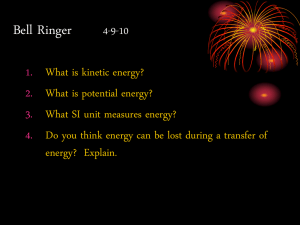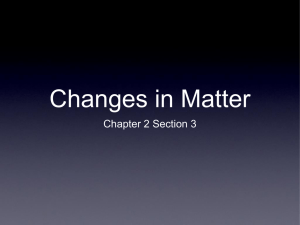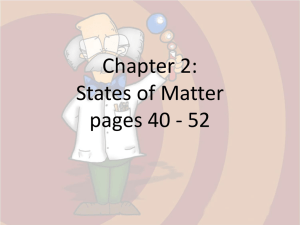Experimental challenges:
advertisement
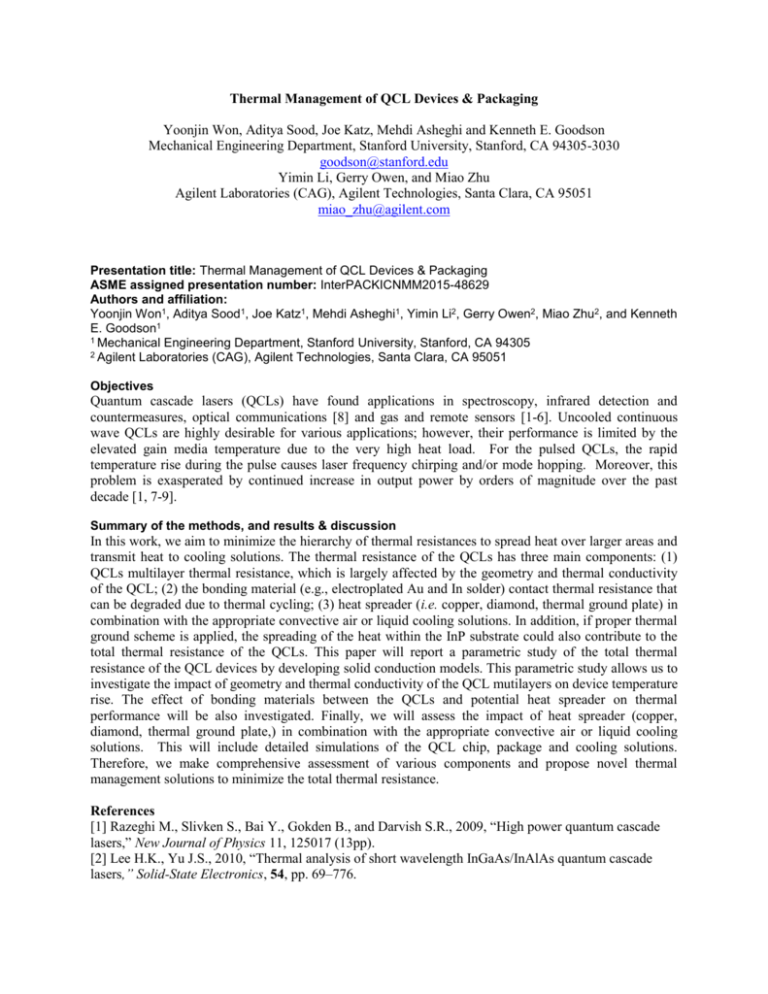
Thermal Management of QCL Devices & Packaging Yoonjin Won, Aditya Sood, Joe Katz, Mehdi Asheghi and Kenneth E. Goodson Mechanical Engineering Department, Stanford University, Stanford, CA 94305-3030 goodson@stanford.edu Yimin Li, Gerry Owen, and Miao Zhu Agilent Laboratories (CAG), Agilent Technologies, Santa Clara, CA 95051 miao_zhu@agilent.com Presentation title: Thermal Management of QCL Devices & Packaging ASME assigned presentation number: InterPACKICNMM2015-48629 Authors and affiliation: Yoonjin Won1, Aditya Sood1, Joe Katz1, Mehdi Asheghi1, Yimin Li2, Gerry Owen2, Miao Zhu2, and Kenneth E. Goodson1 1 Mechanical Engineering Department, Stanford University, Stanford, CA 94305 2 Agilent Laboratories (CAG), Agilent Technologies, Santa Clara, CA 95051 Objectives Quantum cascade lasers (QCLs) have found applications in spectroscopy, infrared detection and countermeasures, optical communications [8] and gas and remote sensors [1-6]. Uncooled continuous wave QCLs are highly desirable for various applications; however, their performance is limited by the elevated gain media temperature due to the very high heat load. For the pulsed QCLs, the rapid temperature rise during the pulse causes laser frequency chirping and/or mode hopping. Moreover, this problem is exasperated by continued increase in output power by orders of magnitude over the past decade [1, 7-9]. Summary of the methods, and results & discussion In this work, we aim to minimize the hierarchy of thermal resistances to spread heat over larger areas and transmit heat to cooling solutions. The thermal resistance of the QCLs has three main components: (1) QCLs multilayer thermal resistance, which is largely affected by the geometry and thermal conductivity of the QCL; (2) the bonding material (e.g., electroplated Au and In solder) contact thermal resistance that can be degraded due to thermal cycling; (3) heat spreader (i.e. copper, diamond, thermal ground plate) in combination with the appropriate convective air or liquid cooling solutions. In addition, if proper thermal ground scheme is applied, the spreading of the heat within the InP substrate could also contribute to the total thermal resistance of the QCLs. This paper will report a parametric study of the total thermal resistance of the QCL devices by developing solid conduction models. This parametric study allows us to investigate the impact of geometry and thermal conductivity of the QCL mutilayers on device temperature rise. The effect of bonding materials between the QCLs and potential heat spreader on thermal performance will be also investigated. Finally, we will assess the impact of heat spreader (copper, diamond, thermal ground plate,) in combination with the appropriate convective air or liquid cooling solutions. This will include detailed simulations of the QCL chip, package and cooling solutions. Therefore, we make comprehensive assessment of various components and propose novel thermal management solutions to minimize the total thermal resistance. References [1] Razeghi M., Slivken S., Bai Y., Gokden B., and Darvish S.R., 2009, “High power quantum cascade lasers,” New Journal of Physics 11, 125017 (13pp). [2] Lee H.K., Yu J.S., 2010, “Thermal analysis of short wavelength InGaAs/InAlAs quantum cascade lasers,” Solid-State Electronics, 54, pp. 69–776. [3] Mukherjee A, Prasanna M, Lane M, Go R, Dunayevskiy I, Tsekoun A and Patel C K N, 2008, “Optically multiplexed multi-gas detection using quantum cascade laser photoacoustic spectroscopy,” Appl. Opt. 47 4884–7. [4] Taslakov M, Simeonov V and van den Bergh H,b 2008, “Line-of-sight data transmission system based on Mid-IR quantum cascade laser,” Proc. SPIE 6877 68770F [5] Van Neste C W, Senesac L R and Thundat T, 2008, “Standoff photoacoustic spectroscopy Appl. Phys. Lett. 92, 234102. [6] Evans A, Darvish S R, Slivken S, Nguyen J, Bai Y and Razeghia M, 2007, “Buried heterostructure quantum cascade lasers with high continuous-wave wall plug efficiency,” Appl. Phys. Lett. 91, 2007, pp. 071101. [7] Bai Y, Darvish S R, Slivken S, Zhang W, Evans A, Nguyen J and Razeghi M, 2008, “Room temperature continuous wave operation of quantum cascade lasers with watt-level optical power,” Appl. Phys. Lett. 92 101105 [8] Lyakh A et al., 2008, “1.6 W high wall plug efficiency, continuous-wave room temperature quantum cascade laser emitting at 4.6μm,” Appl. Phys. Lett. 92 111110 [9] Bai Y, Slivken S, Darvish S R and Razeghi M, 2008, “Room temperature continuous wave operation of quantum cascade lasers with 12.5% wall plug efficiency,” Appl. Phys. Lett. 93 021103 Figures Figure 1. A solid conduction simulation is developed by using COMSOL multiphysics to account for the overall thermal resistance from the heat generation to the convecting area. A heat transfer coefficient of 700W/m2K on the backside. Figure 2. Temperature profiles along the y-axis are plotted to indicate the maximum temperature. The materials of Cu, diamond, and thermal ground plate are selected for the heat spreader. The different materials with a range of thermal conductivity change the temperature profile as well as the maximum temperature.
